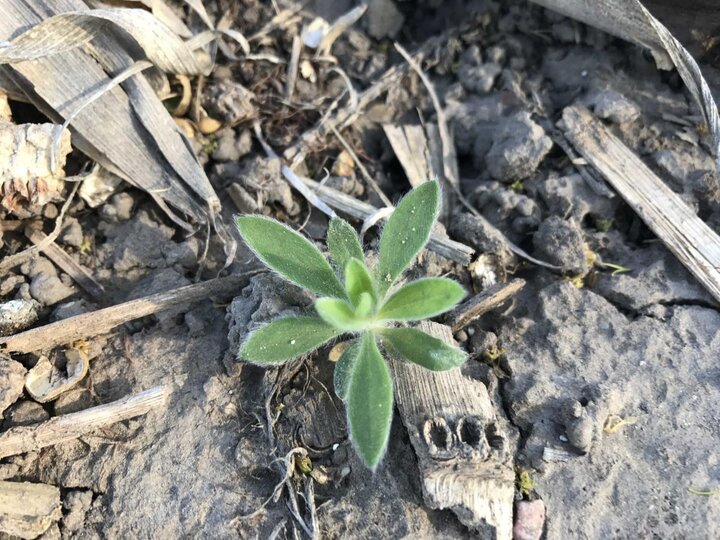Several summer annual weed species in Nebraska emerge early in the season, prior to planting corn and soybean, and need to be controlled before they grow too large. Of particular concern are giant ragweed, kochia, and marestail; we believe there are numerous populations of these species in Nebraska that cannot be controlled by glyphosate.
We are now observing kochia, giant ragweed, and marestail emergence in some of our research plots. If you have had difficulty controlling these weeds in the last few years, make every effort to control these populations with an effective burndown application or tillage prior to planting. Based on observations in our giant ragweed research studies the previous two years, we have not had success controlling glyphosate-resistant giant ragweed with any herbicide program NOT containing 2,4-D as a component of a burndown application. If you apply 2,4-D prior to planting, be sure to adhere to the planting interval specified on the label.
 Figure 1. Kochia seedling (Photo by Amit Jhala)  Figure 2. Emerging giant ragweed in a field near Clay Center. (Photo by Irvin Schleufer) |
Some other common weed species that emerge early in the season in Nebraska fields are common chickweed, dandelion, field pennycress, henbit, tansy mustard, and Virginia pepperweed.
Developing a Successful Early Season Weed Management Program
Profitable crop production starts with a weed control program that includes pre-plant and/or pre-emergence herbicides to deliver long-lasting, residual weed control. A spring burndown program in corn and soybean provides effective weed control to prepare for planting and helps to decrease the seedbank during the season. Early season weed competition can greatly reduce yields and profits.
Burndown
Several studies have shown that if weeds grow to 9 inches, soybean yield can be reduced by as much as 6%; 12-inch weeds can result in up to a 10% yield loss. In corn, 12-inch weeds could cause 22% yield loss when left uncontrolled.
Among the herbicides registered for spring burndown weed control are:
- Corn: 2,4-D*, Aim, atrazine, Balance Flexx, Corvus, dicamba, glyphosate, Landmaster II, Lexar EZ, and Sharpen
- Soybean: 2,4-D* (use esters only), Authority First, glyphosate, Gramoxone, Pursuit, and Sharpen
*If 2,4-D is applied at 16 fl oz/acre in a burndown program, the preplanting interval is seven days for corn and soybean; if 2,4-D is applied at a rate above 16 fl oz/acre in a burndown program, the planting interval should be 14 days for corn and 30 days for soybean.
Pre-emergence
The pre-emergence (residual) herbicide protects the crop with early, effective, and lasting weed control to help maximize yields, regardless of the production system. In addition, including pre-emergence herbicides can minimize the post-emergence herbicide applications and protect against early-season weed competition when weather or busy schedules prohibit a timely post-emergence application. Among the herbicides registered for pre-emergence weed control are:
- Corn: Aatrex, Balance Flexx, Corvus, Degree Extra, Fierce, Lumax EZ, Outlook, Surestart, Tripleflex, and Zemax
- Soybeans: Authority MTZ, Boundry, Command, Dual II Magnum, Envive, Optill, Pursuit, Prowl H2O, Valor XLT, and Warrant
Always read and follow herbicide label directions.
For More Information
For a list of all registered burndown and residual herbicides see the 2014 Guide for Weed Management in Nebraska (EC130) published by University of Nebraska-Lincoln.
Amit Jhala, Extension Weed Management Specialist
Lowell Sandell, Weed Science Extension Educator
4/11/14
